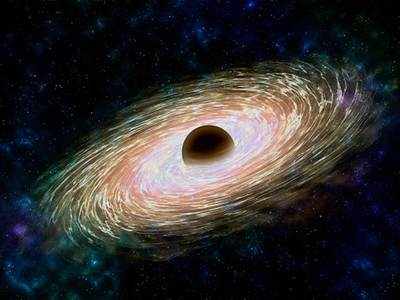- News
- Education News
- News
- Researchers from IIT Bombay, Gandhinagar, help in detecting heaviest and most distant blackhole
Trending
This story is from September 4, 2020
Researchers from IIT Bombay, Gandhinagar, help in detecting heaviest and most distant blackhole

Image is used for representational purpose only. (Getty Images)
MUMBAI: The detection of the heaviest and the most distant black hole so far by a team of researchers from IIT-Bombay and IIT-Gandhinagar, though puzzling to the scientific community, can open up various possibilities in the study of gravitational waves.
Black holes are formed when a massive star collapses and dies. When two black holes in a binary system are in an orbit, they emit gravitational waves and lose energy.When they come close to each other, they collide resulting in a big gravitational wave signal. The scientists from these two institutes detected this signal coming from the collision of two massive black holes using data from the Laser Interferometer Gravitational wave Observatory (LIGO) in the US and the VIRGO detector in Italy, as part of the international LIGO Scientific Collaboration, comprising over 15 countries.
The collision happened about 17.5 billion light years ago, and the signals travelled to earth and were detected on May 21, 2019. “It took us a year to understand and study the data and rule out fake signals,” said Anand Sengupta, from the department of physics at IIT-Gandhinagar. The gravitational wave detected by the researchers has been named GW190521 and is said to have come from the formation of what theorists call an intermediate mass black hole. The results of their findings have been published in Physical Review Letters and The Astrophysical Journal Letters this week.
Black holes are categorized in three types, explained Archana Pai, researcher from IIT-Bombay’s physics department. “The stellar mass black hole, which is less than 100 solar mass (one solar mass is the mass of our sun), the supermassive black holes, ones that weigh 10 lakh solar mass and more and the third was the intermediate mass black hole – which falls in between these two. This particular black hole of 142 solar mass was the result of a collision between two black holes weighing 85 and 66 solar mass, which itself is an interesting event in gravitational wave astronomy due to the intermediate mass black hole remnant, said Pai. While collisions of black holes have been detected earlier by LIGO and Virgo detectors, a collision this massive and of this age was never seen, she said.
The heavier the system, the shorter its duration in the LIGO detector's sensitive bandwidth, which makes it more difficult to study such signals, said Sengupta. “These systems are far away from us and therefore the signals are very weak. We have to use different techniques to comb through the data and compare it with the theoretical models of black holes we know. It took us a year to confirm our findings,” said Sengupta.
He said that basic inputs for their research has come from rich contributions from the LIGO India team from different institutes in the country, including IUCAA Pune, IISER Kolkata, Pune, ICTS Bengaluru, TIFR Mumbai, etc. Sengupta said that what is exciting is the detection of the first intermediate mass black hole, which have been inferred in other optical observations, but not through gravitational wave detection. It is a major breakthrough in astrophysics observations, he added.
Black holes are formed when a massive star collapses and dies. When two black holes in a binary system are in an orbit, they emit gravitational waves and lose energy.When they come close to each other, they collide resulting in a big gravitational wave signal. The scientists from these two institutes detected this signal coming from the collision of two massive black holes using data from the Laser Interferometer Gravitational wave Observatory (LIGO) in the US and the VIRGO detector in Italy, as part of the international LIGO Scientific Collaboration, comprising over 15 countries.
The collision happened about 17.5 billion light years ago, and the signals travelled to earth and were detected on May 21, 2019. “It took us a year to understand and study the data and rule out fake signals,” said Anand Sengupta, from the department of physics at IIT-Gandhinagar. The gravitational wave detected by the researchers has been named GW190521 and is said to have come from the formation of what theorists call an intermediate mass black hole. The results of their findings have been published in Physical Review Letters and The Astrophysical Journal Letters this week.
Black holes are categorized in three types, explained Archana Pai, researcher from IIT-Bombay’s physics department. “The stellar mass black hole, which is less than 100 solar mass (one solar mass is the mass of our sun), the supermassive black holes, ones that weigh 10 lakh solar mass and more and the third was the intermediate mass black hole – which falls in between these two. This particular black hole of 142 solar mass was the result of a collision between two black holes weighing 85 and 66 solar mass, which itself is an interesting event in gravitational wave astronomy due to the intermediate mass black hole remnant, said Pai. While collisions of black holes have been detected earlier by LIGO and Virgo detectors, a collision this massive and of this age was never seen, she said.
“The findings of this massive black hole system has opened up further questions on how these massive black holes are formed, which could probably be the culmination of collision of smaller stellar mass black holes,” said Pai. “The intermediate mass black holes are considered to be building blocks of super massive black holes. It is also a step forward in the study of super massive black holes,” she added. Pai was accompanied in the research by her Ph D student Koustav Chandra.
The heavier the system, the shorter its duration in the LIGO detector's sensitive bandwidth, which makes it more difficult to study such signals, said Sengupta. “These systems are far away from us and therefore the signals are very weak. We have to use different techniques to comb through the data and compare it with the theoretical models of black holes we know. It took us a year to confirm our findings,” said Sengupta.
He said that basic inputs for their research has come from rich contributions from the LIGO India team from different institutes in the country, including IUCAA Pune, IISER Kolkata, Pune, ICTS Bengaluru, TIFR Mumbai, etc. Sengupta said that what is exciting is the detection of the first intermediate mass black hole, which have been inferred in other optical observations, but not through gravitational wave detection. It is a major breakthrough in astrophysics observations, he added.
End of Article
FOLLOW US ON SOCIAL MEDIA










